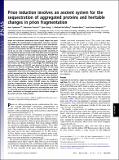Prion induction involves an ancient system for the sequestration of aggregated proteins and heritable changes in prion fragmentation
Author(s)
Tyedmers, Jens; Treusch, Sebastian; Dong, Jijun; McCaffery, J. Michael; Bevis, Brooke J.; Lindquist, Susan; ... Show more Show less
DownloadTyedmers-2010-Prion induction invo.pdf (874.5Kb)
PUBLISHER_POLICY
Publisher Policy
Article is made available in accordance with the publisher's policy and may be subject to US copyright law. Please refer to the publisher's site for terms of use.
Terms of use
Metadata
Show full item recordAbstract
When the translation termination factor Sup35 adopts the prion state, [PSI+], the read-through of stop codons increases, uncovering hidden genetic variation and giving rise to new, often beneficial, phenotypes. Evidence suggests that prion induction involves a process of maturation, but this has never been studied in detail. To do so, we used a visually tractable prion model consisting of the Sup35 prion domain fused to GFP (PrD-GFP) and overexpressed it to achieve induction in many cells simultaneously. PrD-GFP first assembled into Rings as previously described. Rings propagated for many generations before the protein transitioned into a Dot structure. Dots transmitted the [PSI+] phenotype through mating and meiosis, but Rings did not. Surprisingly, the underlying amyloid conformation of PrD-GFP was identical in Rings and Dots. However, by electron microscopy, Rings consisted of very long uninterrupted bundles of fibers, whereas Dot fibers were highly fragmented. Both forms were deposited at the IPOD, a biologically ancient compartment for the deposition of irreversibly aggregated proteins that we propose is the site of de novo prion induction. We find that oxidatively damaged proteins are also localized there, helping to explain how proteotoxic stresses increase the rate of prion induction. Curing PrD-GFP prions, by inhibiting Hsp104’s fragmentation activity, reversed the induction process: Dot cells produced Rings before PrD-GFP reverted to the soluble state. Thus, formation of the genetically transmissible prion state is a two-step process that involves an ancient system for the asymmetric inheritance of damaged proteins and heritable changes in the extent of prion fragmentation.
Date issued
2010-05Department
Massachusetts Institute of Technology. Department of Biology; Whitehead Institute for Biomedical ResearchJournal
Proceedings of the National Academy of Sciences of the United States of America
Publisher
National Academy of Sciences
Citation
Tyedmers, Jens et al. “Prion induction involves an ancient system for the sequestration of aggregated proteins and heritable changes in prion fragmentation.” Proceedings of the National Academy of Sciences 107.19 (2010): 8633 -8638. ©2010 by the National Academy of Sciences.
Version: Final published version
ISSN
0027-8424
1091-6490